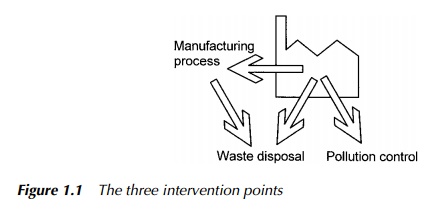Chapter: Environmental Biotechnology: Theory and Application: Introduction to Biotechnology
Scope for Use of Environmental Biotechnology
The Scope for Use
There are three key points for environmental biotechnology
interventions, namely in the manufacturing process, waste management or
pollution control, as shown in Figure 1.1.

Accordingly, the range of
businesses to which environmental biotechnology has potential relevance is
almost limitless. One area where this is most apparent is with regard to waste.
All commercial operations generate waste of one form or another and for many, a
proportion of what is produced is biodegradable. With disposal costs rising
steadily across the world, dealing with refuse constitutes an increasingly high
contribution to overheads. Thus, there is a clear incentive for all businesses
to identify potentially cost-cutting approaches to waste and
Changes in legislation throughout
Europe, the US and elsewhere, have combined to drive these issues higher up the
political agenda and biological methods of waste treatment have gained far
greater acceptance as a result. For those industries with particularly high
biowaste production, the various available treatment biotechnologies can offer
considerable savings.
Manufacturing industries can
benefit from the applications of whole organ-isms or isolated biocomponents.
Compared with conventional chemical processes, microbes and enzymes typically
function at lower temperatures and pressures. The lower energy demands this
makes leads to reduced costs, but also has clear benefits in terms of both the
environment and workplace safety. Additionally, biotechnology can be of further
commercial significance by converting low-cost organic feedstocks into high value
products or, since enzymatic reactions are more highly specific than their
chemical counterparts, by deriving final substances of high relative purity.
Almost inevitably, manufacturing companies produce wastewaters or effluents,
many of which contain biodegradable contaminants, in varying degrees. Though
traditional permitted discharges to sewer or watercourses may be adequate for
some, other industries, particularly those with recalcitrant or highly
concentrated effluents, have found significant benefits to be gained from using
biological treatment methods themselves on site. Though careful moni-toring and
process control are essential, biotechnology stands as a particularly
cost-effective means of reducing the pollution potential of wastewater, leading
to enhanced public relations, compliance with environmental legislation and
quan-tifiable cost-savings to the business.
Those involved in processing
organic matter, for example, or with drying, printing, painting or coating
processes, may give rise to the release of volatile organic compounds (VOCs) or
odours, both of which represent environmental nuisances, though the former is
more damaging than the latter. For many, it is not possible to avoid producing
these emissions altogether, which leaves treating them to remove the offending
contaminants the only practical solution. Especially for relatively low
concentrations of readily water-soluble VOCs or odorous chem-icals, biological
technologies can offer an economic and effective alternative to conventional
methods.
The use of biological
cleaning agents is another area of potential benefit, especially where there is
a need to remove oils and fats from process equipment, work surfaces or drains.
Aside from typically reducing energy costs, this may also obviate the need for
toxic or dangerous chemical agents. The pharmaceutical and brewing industries,
for example, both have a long history of employing enzyme-based cleaners to
remove organic residues from their process equipment. In addition, the
development of effective biosensors, powerful tools which rely on biochemical
reactions to detect specific substances, has brought benefits to a wide range
of sectors, including the manufacturing, engineering, chemical, water, food and
beverage industries. With their ability to detect even small amounts of their
particular target chemicals, quickly, easily and accurately, they have been
enthusiastically adopted for a variety of process monitoring applications,
particularly in respect of pollution assessment and control.
Contaminated land is a
growing concern for the construction industry, as it seeks to balance the need
for more houses and offices with wider social and environmental goals. The
reuse of former industrial sites, many of which occupy prime locations, may typically
have associated planning conditions attached which demand that the land be
cleaned up as part of the development process. With urban regeneration and the
reclamation of ‘brown-field’ sites increasingly favoured in many countries over
the use of virgin land, remediation has come to play a significant role and the
industry has an ongoing interest in identifying cost-effective methods of
achieving it. Historically, much of this has involved simply digging up the
contaminated soil and removing it to landfill elsewhere. Bioremediation
technologies provide a competitive and sustainable alternative and in many
cases, the lower disturbance allows the overall scheme to make faster progress.
As the previous brief
examples show, the range of those which may bene-fit from the application of
biotechnology is lengthy and includes the chemical, pharmaceutical, water,
waste management and leisure industries, as well as man-ufacturing, the
military, energy generation, agriculture and horticulture. Clearly, then, this
may have relevance to the viability of these ventures and, as was mentioned at
the outset, biotechnology is an essentially commercial activity. Environmental
biotechnology must compete in a world governed by the bestpracticable environmental option (BPEO) and the best available techniques not entailing
excessive cost (BATNEEC). Consequently, the economic aspect willalways have
a large influence on the uptake of all initiatives in environmental
biotechnology and, most particularly, in the selection of methods to be used in
any given situation. It is impossible to divorce this context from the
decision-making process. By the same token, the sector itself has its own
implications for the wider economy.
Related Topics